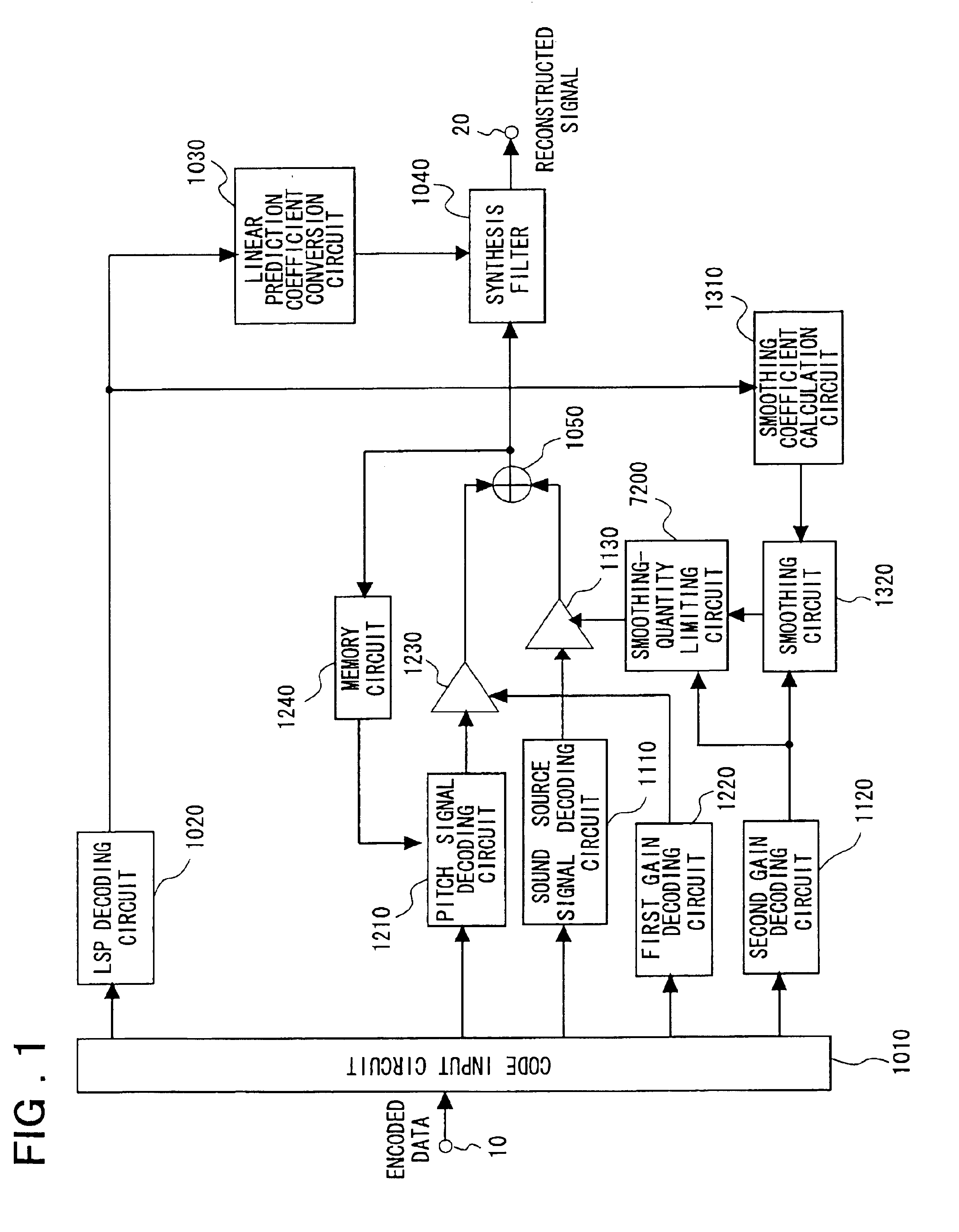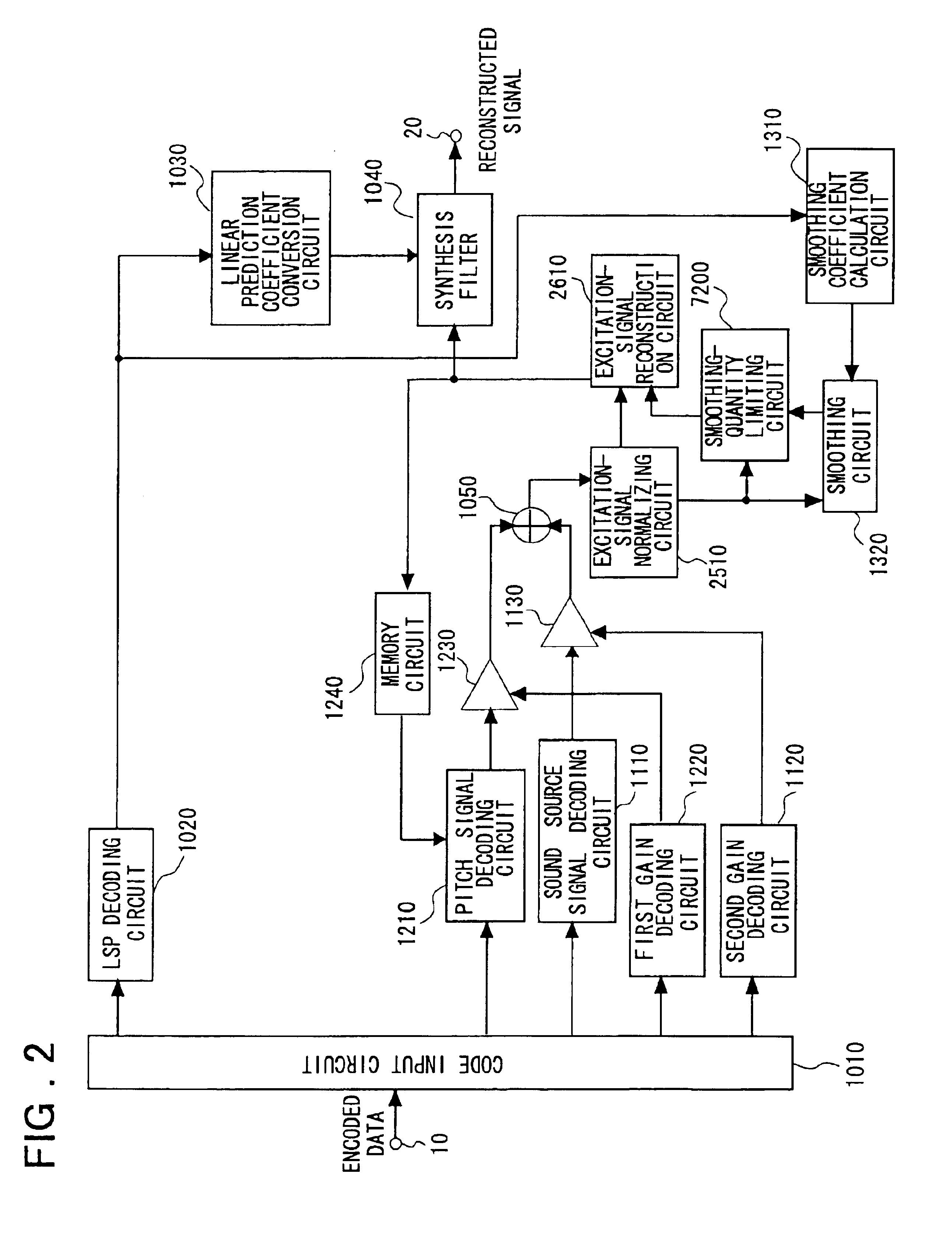Speech signal decoding method and apparatus, speech signal encoding/decoding method and apparatus, and program product therefor
a speech signal and decoding technology, applied in the field of speech signal decoding methods and apparatus, can solve problems such as abnormal sound produced in noise segments
- Summary
- Abstract
- Description
- Claims
- Application Information
AI Technical Summary
Benefits of technology
Problems solved by technology
Method used
Image
Examples
first embodiment
[0101]FIG. 1 is a block diagram illustrating the construction of a speech signal decoding apparatus according to the present invention. Components in FIG. 1 identical with or equivalent to those shown in FIG. 8 are identified by like reference characters.
[0102]In FIG. 1, the input terminal 10, output terminal 20, code input circuit 1010, LSP decoding circuit 1020, linear prediction coefficient conversion circuit 1030, sound source signal decoding circuit 1110, memory circuit 1240, pitch signal decoding circuit 1210, first gain decoding circuit 1220, second gain decoding circuit 1120, first gain circuit 1230, second gain circuit 1130, adder 1050, smoothing coefficient calculation circuit 1310, smoothing circuit 1320 and synthesis filter 1040 are identical with the similarly identified components shown in FIG. 8 and need not be described again. The entire description made in the introductory part of this application with respect to FIG. 8 is hereby incorporated as part of the disclosu...
second embodiment
[0116]the present invention will now be described.
[0117]FIG. 2 is a block diagram illustrating the construction of a speech signal decoding apparatus according to a second embodiment of the present invention. Components in FIG. 2 identical with or equivalent to those shown in FIGS. 1 and 8 are identified by like reference characters.
[0118]As shown in FIG. 2, the second embodiment is so adapted that the norm of the excitation vector is smoothed instead of the decoded sound source gain (the second gain) as in the first embodiment. It should be noted that the input terminal 10, output terminal 20, code input circuit 1010, LSP decoding circuit 1020, linear prediction coefficient conversion circuit 1030, sound source signal decoding circuit 1110, memory circuit 1240, pitch signal decoding circuit 1210, first gain decoding circuit 1220, second gain decoding circuit 1120, first gain circuit 1230, second gain circuit 1130, adder 1050, smoothing coefficient calculation circuit 1310, smoothin...
third embodiment
[0124]the present invention will now be described.
[0125]FIG. 3 is a block diagram illustrating the construction of a speech signal decoding apparatus according to a second embodiment of the present invention. Components in FIG. 3 identical with or equivalent to those shown in FIGS. 2 and 8 are identified by like reference characters. The input terminal 10, output terminal 20, code input circuit 1010, LSP decoding circuit 1020, linear prediction coefficient conversion circuit 1030, sound source signal decoding circuit 1110, memory circuit 1240, pitch signal decoding circuit 1210, first gain decoding circuit 1220, second gain decoding circuit 1120, first gain circuit 1230, second gain circuit 1130, adder 1050, smoothing coefficient calculation circuit 1310, smoothing circuit 1320 and synthesis filter 1040 are identical with the similarly identified components shown in FIG. 8, and the excitation-signal normalizing circuit 2510 and excitation-signal reconstruction circuit 2610 are ident...
PUM
 Login to View More
Login to View More Abstract
Description
Claims
Application Information
 Login to View More
Login to View More - R&D
- Intellectual Property
- Life Sciences
- Materials
- Tech Scout
- Unparalleled Data Quality
- Higher Quality Content
- 60% Fewer Hallucinations
Browse by: Latest US Patents, China's latest patents, Technical Efficacy Thesaurus, Application Domain, Technology Topic, Popular Technical Reports.
© 2025 PatSnap. All rights reserved.Legal|Privacy policy|Modern Slavery Act Transparency Statement|Sitemap|About US| Contact US: help@patsnap.com



